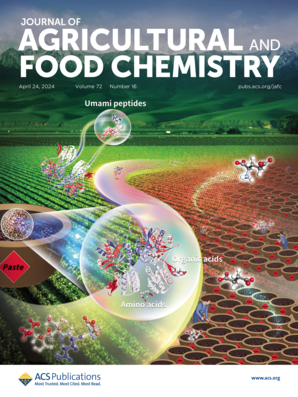香菇β-葡聚糖体外肠道发酵过程中的结构动力学、肠道菌群调节及免疫影响
IF 6.2
1区 农林科学
Q1 AGRICULTURE, MULTIDISCIPLINARY
引用次数: 0
摘要
本研究通过模拟消化和结肠发酵研究了香菇β-葡聚糖(SBG)的结构-功能关系。SBG由β-(1→3)-连接的葡聚糖骨架和β-(1→6)-连接的侧链组成,在上胃肠道表现出明显的酶和酸降解抗性。在体外结肠发酵过程中,59%的碳水化合物在48 h内被消耗,pH显著降低,短链脂肪酸产量增加1.5倍。微生物组分析表明,SBG增加了拟杆菌和乳酸杆菌的数量,同时抑制了埃希氏杆菌-志贺氏菌。在前12 h内,SBG保持刚性三螺旋结构,分支率从48.02略微下降到44.26%。24 h后,三螺旋解绕,48 h时主干发生广泛解聚。发酵初期免疫调节活性保持不变,但随着三螺旋结构的破坏,免疫调节活性下降。这些发现强调了分子刚性和构象完整性在β-葡聚糖在食品和治疗应用中的功能中的关键作用。本文章由计算机程序翻译,如有差异,请以英文原文为准。

Structural Dynamics, Gut Microbiota Modulation, and Immunological Impacts of Shiitake Mushroom β-Glucan during In Vitro Intestinal Fermentation
This study investigated the structure–function relationship of shiitake β-glucan (SBG) through simulated digestion and colonic fermentation. SBG, composed of β-(1 → 3)-linked glucan backbones with β-(1 → 6)-linked side chains, exhibited notable resistance to enzymatic and acidic degradation in the upper gastrointestinal tract. During in vitro colonic fermentation, 59% of carbohydrates were consumed within 48 h, with a significant pH reduction and a 1.5-fold increase in short-chain fatty acid production. Microbiome analysis demonstrated that SBG enhanced Bacteroides and Lactobacillus populations, while suppressing Escherichia-Shigella. Within the first 12 h, SBG maintained a rigid triple-helix structure, with a slight decrease in branching from 48.02 to 44.26%. After 24 h, the triple helix unwound, and extensive depolymerization of the backbone occurred by 48 h. Immunomodulatory activity was preserved early in fermentation but decreased as the triple-helix structure broke down. These findings emphasize the critical role of molecular rigidity and conformational integrity in β-glucan’s functionality for food and therapeutic applications.
求助全文
通过发布文献求助,成功后即可免费获取论文全文。
去求助
来源期刊
CiteScore
9.90
自引率
8.20%
发文量
1375
审稿时长
2.3 months
期刊介绍:
The Journal of Agricultural and Food Chemistry publishes high-quality, cutting edge original research representing complete studies and research advances dealing with the chemistry and biochemistry of agriculture and food. The Journal also encourages papers with chemistry and/or biochemistry as a major component combined with biological/sensory/nutritional/toxicological evaluation related to agriculture and/or food.

 求助内容:
求助内容: 应助结果提醒方式:
应助结果提醒方式:


